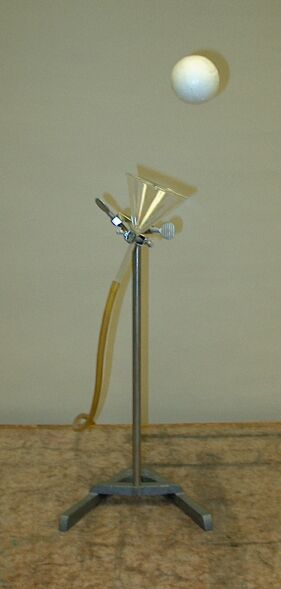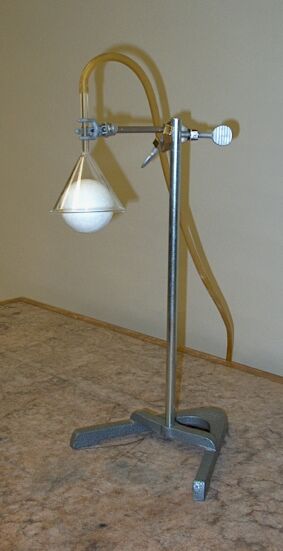 |
 |
A high-speed air stream holds a ball in place above or beneath a funnel. (You can hold the funnel by hand; the stand and clamp are for purposes of photography.)
With the hose attached to the compressed air tap, open the valve to give a healthy air flow. To support the ball in the air stream, as in the photograph at left, hold the funnel vertically, and place the ball some distance above it, in the center of the air stream. By releasing it gently when it is sitting in the middle of the stream, you should be able to get it to float above the funnel. Once you are satisfied that the ball is stable, you can then tilt the funnel, as shown in the photograph, and the ball will remain floating. If the air flow is sufficient, you will probably be able to tilt the funnel far enough that the ball no longer sits above the funnel; that is, if it were to fall straight down, it would miss the funnel. You can also hold the funnel upside-down, and either place it just over the ball to lift the ball, or place the ball inside it. Either way, the ball will be pulled into the funnel and stay there as the air flows around it.
What is happening?
The physics of both of these situations is explained by Bernoulli’s theorem, which describes the steady flow of a nonviscous, incompressible fluid. It states that
p + (1/2)ρv2 + ρgy = constant.
(Some people might be used to seeing this equation stated as (p/ρ) + (1/2)v2 + φ = constant, where φ = gy.) This is strictly true only for flow along a particular streamline of the fluid. If, however, we make the additional simplification that the flow is irrotational, then it applies for flow at any point in the fluid. This equation contains the sum of the static pressure, the pressure that would be present even if there were no flow, which is p + ρgy, and the dynamic pressure, (1/2)ρv2, which arises from the fluid flow. A note on its derivation follows the explanation of the demonstration.
When you flow air through the funnel, in front of the air stream the (dynamic) pressure, due to the flow, is high enough that, over the (cross-sectional) area of the ball, it generates enough force to counter gravity and support the ball. Because the stream diverges, the dynamic pressure varies along its length. If the ball falls closer to the nozzle, the pressure increases, raising the ball. If the ball rises too high, the pressure decreases, and it falls back to the equilibrium position. What keeps the ball centered, if it is not too greatly displaced, is that if it moves from the center of the air stream, the (static) pressure in the fast-moving core of the stream, which is now flowing past the ball, is lower than the pressure of the air on the opposite side of the ball, where the flow is not as fast (and there is less flowing air and more stagnant air). This pressure differential pushes the ball back to the center of the air stream. When you tilt the funnel, these mechanisms keep the ball centered in the jet, and afloat, as long as you don’t tilt it so far that the upward forces generated by the stream on the ball no longer balance gravity.
As noted above, if you turn the funnel upside-down, you can either pick up the ball with it, or place the ball directly under it and let it be pulled into the funnel. What happens in this situation is that as you bring the ball close to the funnel, the air flow is now restricted to the space between the ball and the funnel. As this space narrows, the speed of the air flowing through it increases, thus reducing the static pressure in this region. Once the difference between this pressure and the static pressure underneath the ball exceeds gravity, the ball is pushed up into the funnel by the air beneath it. If it goes too far into the funnel, some of the air flow is cut off, raising the static pressure above the ball, and it falls until the air flow is restored to where this pressure is again low enough that the pressure beneath the ball can again push the ball into the funnel. The ball thus sits inside the funnel, clattering as it repeatedly falls a bit, then rises, over and over again.
One can arrive at the Bernoulli equation in one of at least two ways. It arises from a formal mathematical treatment of the equations of motion for a fluid, which are similar to those for electrodynamics. Since it is essentially a statement of the conservation of energy, one can also derive it by means of the work-energy theorem. We can envision fluid flowing through a tube with an entrance having a particular cross-sectional area, A1, and an exit at a different height, with an area A2. If we consider a particular volume of fluid at the entrance and at the exit, these correspond to a length l1 at the entrance and l2 at the exit. If we call the entrance pressure p1, the exit pressure p2, and the entrance and exit heights y1 and y2, respectively, we can calculate the total work done on the fluid (by the sum of pressure and gravitational forces) as p1A1l1 - p2A2l2 - mg(y2 - y1). The product of area and length is volume, which we can also write as m/ρ, so this becomes (p1 - p2)(m/ρ) - mg(y2 - y1). By the work-energy theorem, this work must equal the kinetic energy change for the volume element, which we can express as (1/2)mv22 - (1/2)mv12. Equating these gives:
(p1 - p2)(m/ρ) - mg(y2 - y1) = (1/2)mv22 - (1/2)mv12,
which we can rearrange as p1 + (1/2)ρv12 + ρgy1 = p2 + (1/2)ρv22 + ρgy2. Since the subscripts can refer to any two points along the tube, we can drop them and replace the right side of this equation with a constant to give the Bernoulli equation as stated above.
References:
1) Feynman, Richard P., Leighton, Robert B. and Sands, Matthew. The Feynman Lectures on Physics, Volume II, Mainly Electromagnetism and Matter (Reading, Massachusetts: Addison-Wesley Publishing Company, 1963) 40-2 to 40-9.
2) Resnick, Robert and Halliday, David. Physics, Part One, Third Edition (New York: John Wiley and Sons, 1977), pp. 386-391.